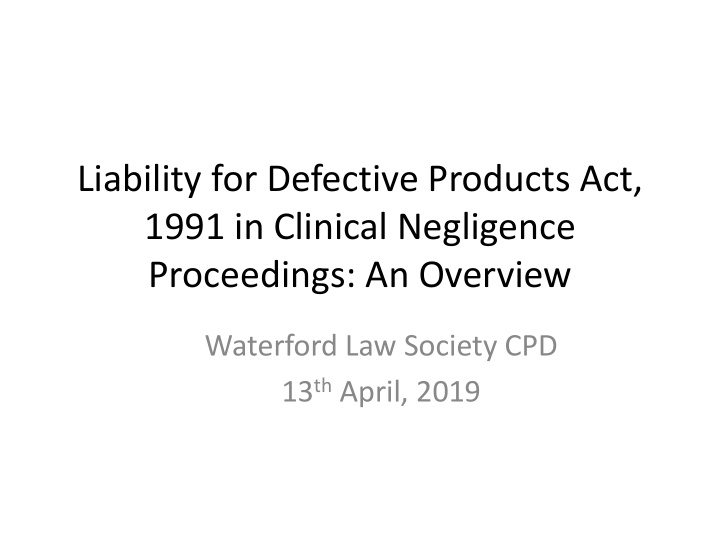



Liability for Defective Products Act, 1991 in Clinical Negligence Proceedings: An Overview Waterford Law Society CPD 13 th April, 2019
Criteria for application of 1991 Act • Product (or component thereof) must be produced / manufactured / processed by the Defendant, or • Any person putting name / trade mark holding themselves out as producer of the product, or • Person importing that product into the EU, or • Person who does not identify the supplier within a reasonable time after having been asked to identify the supplier
• Damage, being death or personal injury, or • Loss or destruction of an item other than the product itself, provided that the product was intended for private use / consumption and was mainly so used / consumed. • Defect – product fails to provide level of safety which a person is reasonably entitled to expect;
– Having regard to presentation of the product, the use to which the product could reasonably be put, and the time when the product was put into circulation. – Product not defective solely by reason of a better product later being put into circulation. Causation; between damage or loss and the defect.
Defences • Limitation periods; Section 7 of 1991 Act – 3 years for product liability; includes provision for date of knowledge O’hAonghasa v DCC (Hogan J). Medical product case. – Ten years after the actual product was put into circulation (applies whether or not the action accrued or time began to run under the three year limitation period).
• Section 6 (e) Defence – state of scientific and technical knowledge when product put into circulation could not have revealed the defect.
• Provision for contribution between wrongdoers pursuant to Part III Civil Liability Act, 1961. • Provision for contributory negligence. • Council Directive 85/374/EEC of 25 July, 1985 (Scheduled to the 1991 Act) takes precedence to the wording of the 1991 Act itself.
Section 3 (d) PIAB Acts, 2003 to 2019 • Does Defective Product Liability case require PIAB Authorisation? • Gunning v National Maternity Hospital [2009] IR 117; HC O’Neill J; Part of broken forceps left in Plaintiff. • “The factual circumstances out of which the Plaintiff’s personal injury claim arises, in my view, clearly occurred in the course of “...the carrying out of a medical procedure ...”
• and are well within the provisions of section 3 (d) of the Acts of 2003” . • Therefore no PIAB Authorisation required. • Legislature cannot have intended that two parts of the same claim be processed differently – clinical negligence part directly through the Courts and products liability part through PIAB.
• Randa Murphy v DePuy Intl. Ltd [2015] IEHC 153; Faherty J • “The focus of the Plaintiff’s claim is on the Defendant’s connection (qua manufacturer and supplier) to the hip implant which she received”.
• “Notwithstanding that the alleged defective hip was received by the Plaintiff in the course of medical treatment, to my mind, this cannot convert the genesis of this action...into the provision of a health service to the Plaintiff”. • No clinical negligence alleged.
• Defective Products claim needs PIAB Authorisation • Appeal to CA dismissed as moot. Plaintiff already had second set of proceedings issued which had a PIAB Authorisation.
• Joseph Creedon v DePuy Intl Ltd [2018] IEHC 790; O Hanlon J • Date of knowledge: October, 2010; • PI Summons issued: 23rd March, 2011. • Defence filed: 18th June, 2013 – pleaded lack of PIAB Authorisation. • Plaintiff argued that no Authorisation needed as case fell within Section 3 (d) PIAB Acts.
• Held; Randa Murphy v DePuy decision followed. No factors to distinguish from the Randa Murphy case. • Could Plaintiff in Creedon have applied to PIAB on receipt of Defence? Probably still within 3-year time limit for 1991 Act.
Types of Products • DePuy hip cases • PIP breast implant cases • Surgical devices – Surgical tools; Sutures; • Items / parts of items incorrectly left in situ - Forceps; Wound draining tubes; • Needlestick injuries – protective cover on syringes
• Skin treatments – Cosmetic blemishes • Hospital beds
Practical Considerations • Lower burden than for clinical negligence. • Longer limitation period. • Surgeon claiming defective medical product. • Manufacturer claiming negligent surgery / care. • Surgical notes may assist.
Medical Negligence vs Defective Products Act • Professional Negligence Defective Products Act High Burden of Proof Lower burden of proof Expert Report Required Expert Report Not Required (Though may be Desirable) Exempt from PIAB Application PIAB Authorisation Required 2-year Limitation Period 3-year Limitation Period (Section 221 LSR Act – extend to 3 years for Clinical Negligence. Not yet commenced)
No PIAB / post-PIAB Statute PIAB / post-PIAB Statute Suspension Suspension – new Section 50 of PIAB Acts Proceedings against a Professional Proceedings against a multi- national company
Recommend
More recommend